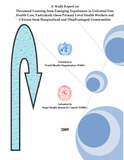Please use this identifier to cite or link to this item:
https://hdl.handle.net/20.500.14356/790Full metadata record
| DC Field | Value | Language |
|---|---|---|
| dc.contributor.author | Nepal Health Research Council (NHRC), Ramshah Path, Kathmandu, Nepal | |
| dc.date.accessioned | 2012-12-28T20:00:03Z | |
| dc.date.accessioned | 2022-11-08T10:20:43Z | - |
| dc.date.available | 2012-12-28T20:00:03Z | |
| dc.date.available | 2022-11-08T10:20:43Z | - |
| dc.date.issued | 2009 | |
| dc.identifier.uri | http://103.69.126.140:8080/handle/20.500.14356/790 | - |
| dc.description.abstract | Background of the Study: Nepal with a population of 23 million (Census 2001)is one of the poorest countries in the world with the annual per capita income of US$240 per year, GDP per capita value in 2007/08 was 1,550 PPP US$ (MOHP Nepal, 2004). More than 30% of population lives below the national poverty line. The share of out of pocket expenditure in the total health expenditure is 62 percent (Prasai et al 2006), and many of the poor people do not have right access to treatment during illness. Unequal distribution of health facilities continues to be a major public health problem in Nepal. Although there is an improved trend of mortality among infants and children (DHS 2006) but the sub national health indicators show considerable disparities across the country's geographical regions and social classes. | en_US |
| dc.language.iso | en_US | en_US |
| dc.publisher | Nepal Health Research Council | en_US |
| dc.subject | Free Health care | en_US |
| dc.title | A Study Report on Document Learning from Emerging Experiences in Universal Free Health Care, Particularly those Primary Level Health Workers and Citizens from Marginalized and Disadvantaged Communities | en_US |
| dc.type | Technical Report | en_US |
| Appears in Collections: | NHRC Research Report | |
Items in DSpace are protected by copyright, with all rights reserved, unless otherwise indicated.

